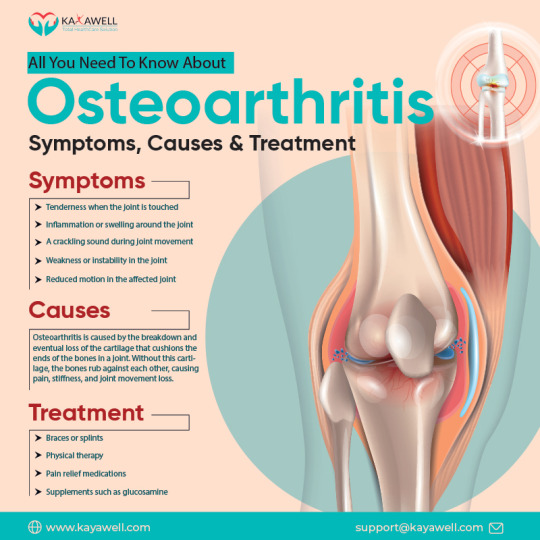#Types of Osteoarthritis
Explore tagged Tumblr posts
Text
Causes of Osteoarthritis

Here know, Causes of Osteoarthritis. Types of Osteoarthritis. Osteoarthritis Symptoms. Osteoarthritis Diagnosis. How to Prevent Osteoarthritis?
#Osteoarthritis Treatment#What Are The 4 Stages of Osteoarthritis?#How to Prevent Osteoarthritis#Types of Osteoarthritis#Osteoarthritis Symptoms#I Cured My Osteoarthritis#Osteoarthritis Diagnosis#Pathophysiology of Osteoarthritis
0 notes
Text
Osteoarthritis Types, Risk Factors & Prevention
Osteoarthritis is the most common form of arthritis. Cartilage is the tough, fibrous connective tissue that cushions and protects the ends of bones where they meet to form a joint. It often develops slowly over time, and the symptoms can vary from person to person. Some people may only experience minor problems, while others may have more severe symptoms that significantly impact their quality of life.
Different Types of Osteoarthritis:
There are different types of osteoarthritis, each with its unique symptoms, signs, and causes.
The most common type is degenerative osteoarthritis, caused by the joints’ wear and tear over time. This type of osteoarthritis usually affects the hands, knees, and hips.
Rheumatoid arthritis is another type of osteoarthritis caused by an autoimmune disorder. This type of arthritis usually affects the hands, feet, and knees.
Psoriatic arthritis is another type of osteoarthritis caused by psoriasis, a skin condition. This type of arthritis usually affects the hands, nails, and feet.
Osteoarthritis Risk Factors:
There are several osteoarthritis risk factors, including:
Age – Osteoarthritis risk increases as people get older.
Genetics – Some people are born with a higher risk of developing osteoarthritis.
Obesity – Being overweight or obese increases the risk of developing osteoarthritis.
Previous Joint Injuries – These can damage the joint and increase the risk of developing osteoarthritis.
Occupational Hazards – Jobs that involve repetitive movements or heavy lifting can increase the risk of developing osteoarthritis.
Sports injuries – Can damage the joints and increase the risk of developing osteoarthritis.
Prevention of Osteoarthritis:
First, it’s essential to maintain a healthy weight. Excess weight stresses your joints, which can worsen osteoarthritis pain.
Second, if you have a job that requires repetitive motions or puts stress on your joints, take steps to reduce your exposure to these risk factors. This might mean changing how you do specific tasks or using assistive devices.
Third, stay active and exercise regularly. Exercise helps maintain strong muscles and joints and can improve flexibility. But be sure to avoid high-impact activities that can put too much stress on your joints.
Last but not least, follow a healthy diet. Add fruits, vegetables, and whole grains to your daily meals. These foods are rich in antioxidants and other nutrients that can help protect your joints from damage.
Source URL: https://www.kayawell.com/blog/all-you-need-to-know-about-osteoarthritis-treatment-symptoms-signs-causes
#Osteoarthritis causes#Osteoarthritis risk factors#Types of osteoarthritis#Osteoarthritis prevention#Osteoarthritis symptoms#Osteoarthritis cure
0 notes
Text
cons of having arthritis: pain
pros of having arthritis: get to wear fingerless gloves and look stylin'
128 notes
·
View notes
Text
Let's Talk About GLP-1 receptor agonists (GLP1-RAs)
GLP-1 receptor agonists (GLP1-RAs), including Tirzepatide and Semaglutide, are showing promise not just in managing type 2 diabetes but also in addressing inflammatory and neurodegenerative conditions. These medications have demonstrated benefits beyond blood sugar control, such as anti-inflammatory and neuroprotective effects. Research indicates that they may potentially aid in the treatment of…
#Dementia Prevention#Diabetes Medications#GLP-1 Receptor Agonists#health#Inflammation Reduction#life lessons#metabolic health#Neurodegenerative Diseases#Neuroprotection#Science research#Self Improvement#Semaglutide Osteoarthritis#Tirzepatide Benefits#Type 2 Diabetes Treatments
0 notes
Text

Bone and joint disorders caused by diabetes
One of the little-known issues that diabetics must also face is fragility in their bones and joints. This article takes a closer look at the major bone and joint disorders that come with type 2 diabetes, symptoms, and treatments.
Read more: https://www.freedomfromdiabetes.org/blog/post/bone-and-joint-disorders-caused-by-diabetes/2946
#bone and joint#bone and joint pain#bone and joint disorders#diabetes joint pain#diabetes joint pain treatment#Type 2 diabetes and arthritis#Diabetic hand syndrome#Charcot's joint#Osteoarthritis#Diffuse idiopathic skeletal hyperostosis#Osteoporosis
0 notes
Text
Enhancing Joint Health Type 2 Collagen Peptides and Biopeptide Supplements

Discover the potential benefits of Type 2 Collagen Peptides and Biopeptide Collagen supplements in supporting joint health and managing osteoarthritis symptoms. Explore their efficacy in promoting cartilage repair and relieving joint discomfort, offering hope for improved mobility and quality of life.
For More:
0 notes
Text

Explore essential information about Osteoarthritis (OA) and its effects on joints. Discover common symptoms, causes, diagnosis methods, and available treatments to manage OA effectively and improve joint health.
#What is osteoarthritis#Osteoarthritis (OA)#osteoarthritis types#causes of osteoarthritis#osteoarthritis symptoms#arthritis osteoarthritis#osteoarthritis knee
0 notes
Text
0 notes
Text
https://lambodarhospital.com/diabetologist-in-aurangabad/
Diabetologist in Aurangabad | Lambodar Hospital
Seek guidance from a Diabetologist in Aurangabad at Lambodar Hospital for comprehensive diabetes management and personalized care. Don't delay; schedule your consultation with us today!
#diabetologist#diabetes#endocrinologist#health#healthylifestyle#type#wellness#fitness#bones#osteoarthritis#bonedensity#skinissues#osteoporosisawareness#osteoporosisprevention#hypothyroidism#nutrisitulang#obatpatahtulang#imbalance#vitamind#hormonal#drarpitgarg#nyerisendi#arthritis#womenshealth#jointpain#healthybones#pengeroposantulang#calcium#diabetologistinaurangabad#sugarspecialistdoctorinaurangabad
0 notes
Text
The Role of Hormones: Exploring the Endocrine System
The Role of Hormones: Exploring the Endocrine System
Introduction The human body is a complex and intricate machine, with various systems working together to maintain balance and health. Among these systems, the endocrine system plays a crucial role by regulating numerous bodily functions through the release of hormones. Dr. Virendra Patil, a renowned Diabetologist and Endocrinologist in Thane, understands the significance of the endocrine system in maintaining overall well-being. In this article, we will explore the fascinating world of hormones and the pivotal role they play in our health.

Understanding the Endocrine System Before delving into the world of hormones, let's first grasp the fundamentals of the endocrine system. This intricate system consists of glands that secrete hormones directly into the bloodstream. These hormones then travel throughout the body to target organs and tissues, where they exert their effects. The major glands of the endocrine system include the pituitary gland, thyroid gland, adrenal glands, pancreas, and more.
The Power of Hormones Hormones act as messengers, transmitting vital instructions to various organs and tissues. They help regulate a multitude of functions, including:
Metabolism: The thyroid gland, for example, produces hormones that control metabolism, influencing how the body uses energy from food.
Growth and Development: Hormones like growth hormone (produced by the pituitary gland) play a pivotal role in growth during childhood and adolescence.
Stress Response: The adrenal glands release cortisol during stressful situations, helping the body respond to challenges.
Reproduction: Sex hormones, such as estrogen and testosterone, govern reproductive processes and sexual development.
Blood Sugar Control: The pancreas secretes insulin to regulate blood sugar levels, a key factor in diabetes management.
The Endocrine Orchestra Consider the endocrine system as an orchestra where the hormones are the notes and the various glands are the instruments. Our bodies work best when this symphony is perfectly balanced. However, imbalances can result in a number of health problems.
Common Endocrine Disorders Dr. Virendra Patil, with his expertise in Diabetology and Endocrinology, often encounters patients with endocrine disorders. Here are some common conditions:
Diabetes Mellitus: This well-known disorder occurs when the pancreas doesn't produce enough insulin (Type 1) or the body becomes resistant to insulin (Type 2), leading to high blood sugar levels.
Hypothyroidism: A sluggish thyroid gland can result in hypothyroidism, causing symptoms like fatigue, weight gain, and depression.
Hyperthyroidism: An overactive thyroid gland leads to hyperthyroidism, characterized by symptoms such as rapid heart rate, weight loss, and anxiety.
Adrenal Disorders: Conditions like Cushing's syndrome (excess cortisol) and Addison's disease (insufficient cortisol) affect the adrenal glands and can have various symptoms.
Polycystic Ovary Syndrome (PCOS): Common among women, PCOS is associated with hormonal imbalances, leading to irregular periods, weight gain, and fertility issues.
Hormonal Harmony and Health
Maintaining hormonal balance is essential for overall health and well-being. Dr. Virendra Patil, as a specialist in Diabetology and Endocrinology in Thane, emphasizes the importance of regular check-ups and early detection for hormone-related disorders.
Lifestyle and Hormonal Health
Several lifestyle factors can influence hormonal balance:
Diet: A balanced diet with adequate nutrients is crucial for hormone production and regulation.
Exercise: Regular physical activity can help improve insulin sensitivity and hormone balance.
Stress Management: Chronic stress can disrupt hormonal harmony, so stress reduction techniques are essential.
Adequate Sleep: Hormones that control hunger and metabolism might be impacted by inadequate sleep.
Conclusion The endocrine system and its hormones are the silent conductors of our health orchestra, orchestrating numerous bodily functions. The expertise of professionals like Dr. Virendra Patil, a Diabetologist and Endocrinologist in Thane, can help individuals maintain hormonal balance and address endocrine disorders effectively. By understanding the significance of hormones and their role in health, we can take proactive steps towards a healthier, more harmonious life.
#DiabetologistinThane#Endocrinologistinthane#diabetestreatmentinthane#diabetologist#diabetes#endocrinologist#health#healthylifestyle#type#wellness#fitness#bones#osteoarthritis#bonedensity#skinissues#osteoporosisawareness#osteoporosisprevention#hypothyroidism#nutrisitulang#obatpatahtulang#imbalance#vitamind#hormonal#drarpitgarg#kalsium#nyerisendi#arthritis#like#womenshealth#jointpain
1 note
·
View note
Link
Know can PRP be used in Management of Osteoarthiritis
1 note
·
View note
Text
Osteoarthritis Treatment, Symptoms, Signs & Causes
Osteoarthritis is caused by the breakdown and eventual loss of the cartilage that cushions the ends of the bones in a joint. Without it, the bones rub against each other, causing pain, swelling, and stiffness. If you are looking for Osteoarthritis treatment then feel free to visit the Kayawell website for accurate information.

#Osteoarthritis causes#Osteoarthritis risk factors#Types of osteoarthritis#Osteoarthritis prevention#Osteoarthritis treatment#Osteoarthritis symptoms#osteoarthritis cure#osteoarthritis inflammation
0 notes
Text
House voice: I want a spinal cord stimulator for Christmas
#house md#as a cane user i fucking love him#but yeah feeling very hurty today lads#inspired by myself#i hate having osteoarthritis#emmetts typing
16 notes
·
View notes
Link
Is osteoarthritis common?The answer is no unless it’s hereditary. In today’s blog we are going to explore the same fact trending around on What Causes Osteoarthritis – your lifestyle factors or genetic factors?
0 notes
Text
Bone and joint disorders caused by diabetes
This article is originally published on Freedom from Diabetes website, available here.
High blood sugar, which is itself a result of insulin resistance, causes myriad health complications from mild—headaches, fatigue, increased urination, etc., to serious—kidney damage, cardiac arrest, stroke, blindness, etc. One of the little-known issues that diabetics must also face is fragility in their bones and joints.
This article takes a closer look at the major bone and joint disorders that come with type 2 diabetes, symptoms, and treatments.
Osteoporosis
Diffuse idiopathic skeletal hyperostosis
Frozen shoulder
Osteoarthritis
Charcot's joint
Diabetic hand syndrome
If you’re interested to know more about this topic Click here to read.
If you found this blog useful, please recommend it and share it with others!
Also please connect with me on my website, Facebook page, and YouTube if you want to stay in touch or give me any feedback!
#and joint#bone and joint pain#bone and joint disorders#diabetes joint pain#diabetes joint pain treatment#Type 2 diabetes and arthritis#Diabetic hand syndrome#Charcot's joint#Osteoarthritis#Diffuse idiopathic skeletal hyperostosis#Osteoporosis
0 notes